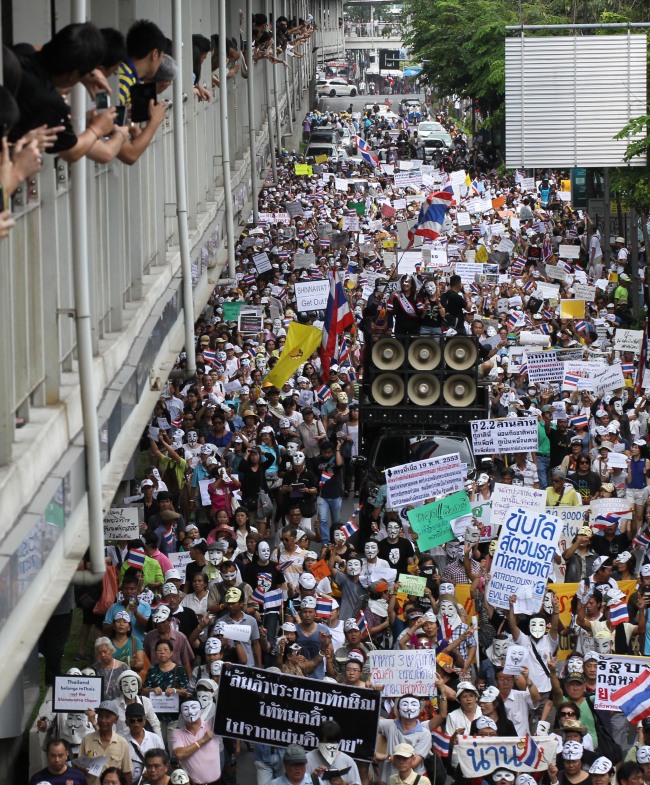Huge street demonstrations have been absent from Thai politics for several months. They are being replaced by smaller protests held by people who connect with one other through cyber space.
These people are frustrated with Yingluck Shinawatra’s administration, like the few hundred protesters who rallied at Sanam Luang over the past two months demanding the Pheu Thai-led government resign.
As the number of Thai Patriotic Front protesters at Sanam Luang has receded, the antigovernment groups on social media have seen the size of their supporters gradually grow. And this is just a few weeks after the groups started using white Guy Fawkes masks as a symbol in their campaign against the so-called Thaksin regime, which includes the government. The groups have held weekly peaceful demonstrations in many provinces all over the country.
What happened to the once-powerful People’s Alliance for Democracy of the yellow shirts, which held massive street protests that led to the ouster of Thaksin Shinawatra’s government in 2006?
Panitan Wattanayagorn, a political scientist at Chulalongkorn University, said cyber protest is stronger than street protest these days because the former has a clearer and stronger point to make in questioning the government.
“People in social media want the prime minister to answer questions about her administration, but she failed to give them the answers. So they felt upset. This led to more people gathering on the streets and more criticism in social media,” he said.
Cyber protest was originally found in countries where there was no freedom of political expression, such as the Middle East, Panitan said. Their people had to discuss politics via social networks and arrange appointments for street rallies. When governments learned about the movement, it was too late to deal with it, he said.
These people are frustrated with Yingluck Shinawatra’s administration, like the few hundred protesters who rallied at Sanam Luang over the past two months demanding the Pheu Thai-led government resign.
As the number of Thai Patriotic Front protesters at Sanam Luang has receded, the antigovernment groups on social media have seen the size of their supporters gradually grow. And this is just a few weeks after the groups started using white Guy Fawkes masks as a symbol in their campaign against the so-called Thaksin regime, which includes the government. The groups have held weekly peaceful demonstrations in many provinces all over the country.
What happened to the once-powerful People’s Alliance for Democracy of the yellow shirts, which held massive street protests that led to the ouster of Thaksin Shinawatra’s government in 2006?
Panitan Wattanayagorn, a political scientist at Chulalongkorn University, said cyber protest is stronger than street protest these days because the former has a clearer and stronger point to make in questioning the government.
“People in social media want the prime minister to answer questions about her administration, but she failed to give them the answers. So they felt upset. This led to more people gathering on the streets and more criticism in social media,” he said.
Cyber protest was originally found in countries where there was no freedom of political expression, such as the Middle East, Panitan said. Their people had to discuss politics via social networks and arrange appointments for street rallies. When governments learned about the movement, it was too late to deal with it, he said.

“For Thailand, cyber protest is a new phenomenon that we should keep an eye on,” Panitan said.
Only one week after it started mobilizing people for rallies, the Guy Fawkes white maskers’ campaign gained much support. The number of “like” clicks for their “V for Thailand” Facebook page jumped drastically, from a few thousand to more than 70,000, in a matter of days.
Ae, an administrator of “V For Thailand,” said the Guy Fawkes masks were first used in Thailand on International Student Movement Day on Oct. 18 last year.
“The day we introduced the mask in Thailand, we had high hopes that other Thais would wear it and come out to reveal their problems in public. We wanted Thais to rise up and fight. The mask has been used internationally as a symbol against all types of dictatorship, including bureaucratic polity, military regimes or parliamentary dictatorial regimes,” Ae said. “I think we have become successful in using the mask in Thailand,” he added, laughing.
Why does political gathering via social media seem to be easier than street protest?
National Institute Development Administration’s rector Sombat Thamrongthanyawong said social media allows everyone easy access and communication among themselves.
“Once members decide to call a rally on the street, a leader will be automatically chosen,” he said. For political rallies in the past, such as the Oct. 14, 1973, student uprising, the leaders carefully planned their street rally, he added.
The white mask group finally came out of cyber space to rally on the streets. Only 700 people gathered in its first rally in Bangkok on June 2. For the second rally last Sunday, the number grew to 3,000. The idea of holding such weekly rallies now has spread into the provinces.
The next question now is for how long will this phenomenon stay in Thai politics, and will the white maskers be able to turn their cyber protest into a powerful street protest?
Green Group coordinator Suriyasai Katasila said he believed the antigovernment social media group would become a part of street politics and looked set to have greater power than the old conventional ones.
According to Suriyasai, social media’s usage has been growing during the past four to five years, with activists using social media to express their political opinions. It is also a new channel where people can share political views. Some political groups do not have physical structures and social media provides them with a great solution. Democrat MP Rachada Dhnadirek saw this as a shift in the means of holding protests. “Facebook users rallying on the streets is another development of people-participation politics,” she said.
Academics and opposition politicians agreed the cyber protesters used new gimmicks to attract supporters. But whether antigovernment movement on social media will gain momentum or become more powerful depends largely on whether the government does anything that jeopardizes the public’s interest.
Another “V For Thailand” administrator who identified himself as “V” said whether or not the white mask movement would grow into a powerful one like the PAD in 2006 or the Oct. 14 uprising depends on the legitimacy of the government.
If the government ensured justice for the people, it would legitimately stay on and the white-mask wearers would mean nothing, he said. But if the government was full of bad politicians, the movement would become a tsunami that would sweep all of them away in the end.
He shrugged off the fact that the number of white maskers on the street is much lower than the number of “likes” in social media.
“What counts is the quality of people joining,” he said. “Besides, supporters of the white maskers have existed in all provinces.”
By Budsarakham Sinlapalavan
(The Nation)
-
Articles by Korea Herald








![[Today’s K-pop] BTS pop-up event to come to Seoul](http://res.heraldm.com/phpwas/restmb_idxmake.php?idx=644&simg=/content/image/2024/04/17/20240417050734_0.jpg&u=)
![[Graphic News] More Koreans say they plan long-distance trips this year](http://res.heraldm.com/phpwas/restmb_idxmake.php?idx=644&simg=/content/image/2024/04/17/20240417050828_0.gif&u=)
![[KH Explains] Hyundai's full hybrid edge to pay off amid slow transition to pure EVs](http://res.heraldm.com/phpwas/restmb_idxmake.php?idx=644&simg=/content/image/2024/04/18/20240418050645_0.jpg&u=20240419100350)






![[KH Explains] Hyundai's full hybrid edge to pay off amid slow transition to pure EVs](http://res.heraldm.com/phpwas/restmb_idxmake.php?idx=652&simg=/content/image/2024/04/18/20240418050645_0.jpg&u=20240419100350)

